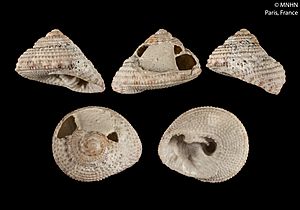Clanculus limbatus facts for kids
Quick facts for kids Clanculus limbatus |
|
|---|---|
 |
|
| Shell of Clanculus limbatus (syntype at MNHN, Paris) | |
| Scientific classification | |
| Synonyms | |
|
Clanculus limbatus, commonly called the keeled clanculus, is a type of sea snail. It is a gastropod mollusk that lives in the ocean. This snail belongs to the family Trochidae, which are often known as top snails.
Contents
What Does the Keeled Clanculus Look Like?
The shell of the keeled clanculus can be between 13 mm and 20 mm long. This is about half an inch to three-quarters of an inch. Its shell has a shape like a cone, but it's a bit flattened. It also has a ridge around its edge.
Shell Colors and Patterns
The shell is usually whitish or yellowish. It often has brown spots or blotches. You might see a line of these spots around the edge of the shell. There can also be spots just below the shell's seams. The space between these spots might be one solid color or have a checkerboard pattern. The bottom of the shell can also have a checkerboard pattern or flame-like markings.
Shell Features
The top part of the shell, called the spire, is low and cone-shaped. The very tip of the spire is smooth. The shell has 5 to 6 whorls, which are the spiral turns of the shell. These turns are a bit rounded near the seams and then flatten out. The last and largest turn of the shell has 6 to 8 spiral ridges. The bottom of the shell is slightly rounded.
The opening of the shell, called the aperture, is somewhat square-shaped. The outer edge of this opening has small ridges inside. The central pillar of the shell, called the columella, is slanted and has small tooth-like bumps. The shell also has a wide, funnel-shaped belly button-like opening called the umbilicus.
Where Does the Keeled Clanculus Live?
This sea snail lives only in Australia. You can find it off the coasts of South Australia, Tasmania, Victoria, and Western Australia. When a species lives only in one specific area, it is called endemic to that place.

